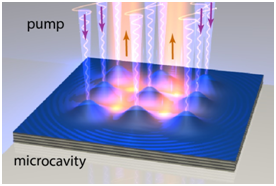QUANTUM OPTOELECTRONICS LABORATORY OF THE ICP
Single polariton nonlinearities Exciton polaritons are composite quasiparticles resulting from the strong coupling of cavity photons and quantum well (QW) excitons embedded within a microcavity (MC) [1]. Polaritons interact nonlinearly due to their excitonic component and can form macroscopically coherent condensates [2]. They are scalable to form arrays by either etching [3] or optical patterni...[More] |
Spin lattices of polariton condensates for quantum sumulation Optical lattices have attracted much attention, since they can replicate quantum phase transition between the superfluid and Mott-insulating states of the Bose-Hubbard model. By experimentally modifying the lattice depth, one can control the relative strengths of the on-site interaction and inter-site hopping amplitude, Such systems h...[More] |
Hybrid Organic-Inorganic Microcavities Organic materials exhibit exceptional room temperature light emitting characteristics and enormous exciton oscillator strength, however, their low charge carrier mobility prevent their use in high-performance applications such as electrically pumped lasers. In this context, ultralow threshold polariton lasers, whose operation relies on Bose-Einstein condens...[More] |